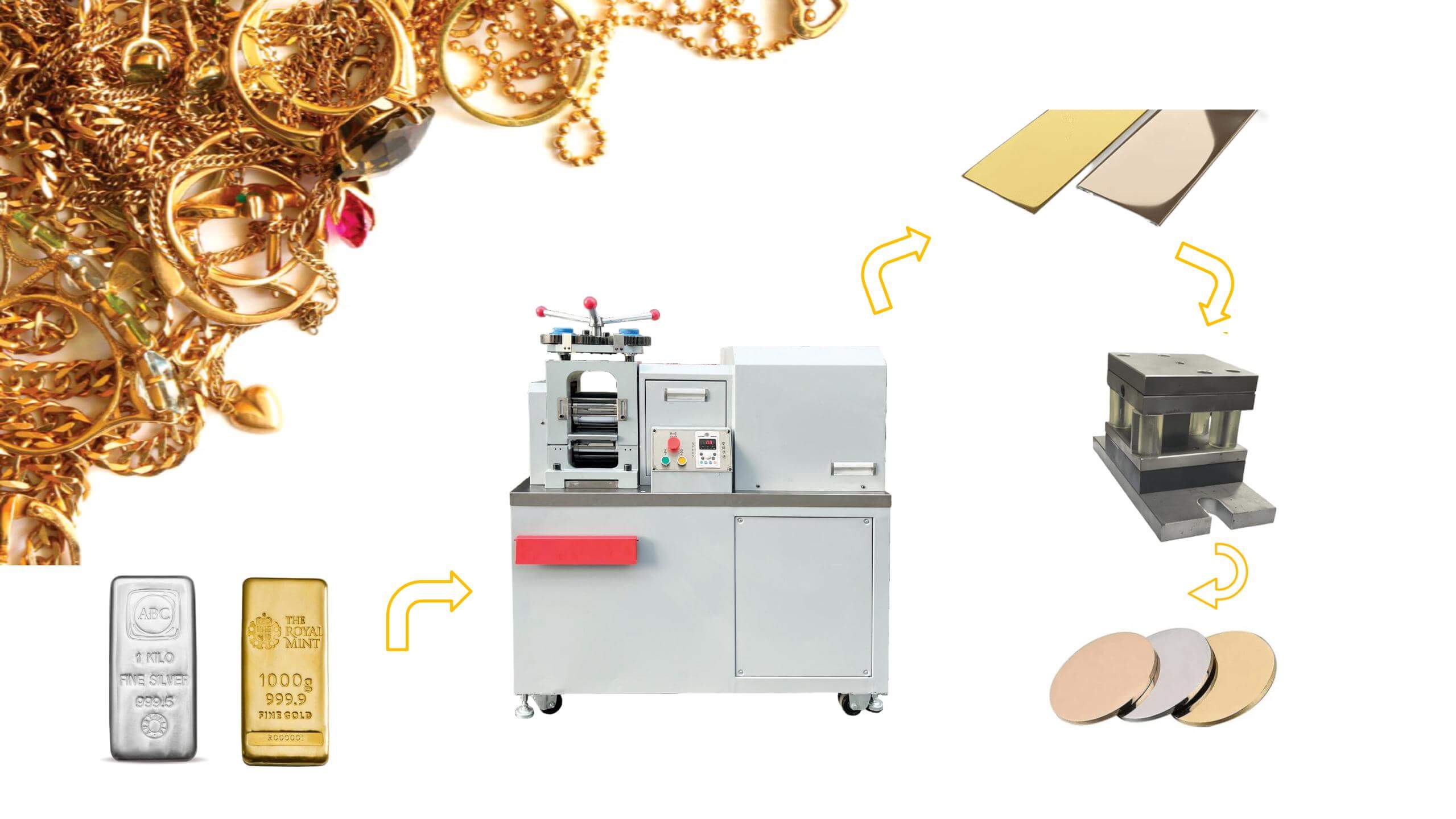The Importance of the Rolling Mill in the Coinage Line
The Importance of the Rolling Mill in the Coinage Line
In the coin minting process, the treatment by the rolling mill is a fundamental and decisive step in producing both coin blanks and the final finished coins. Its importance is far more than simply “thinning the metal”; it is reflected in the following core aspects:
It can be said that without precisely controlled rolling, high-quality coins cannot be produced.
The following are the specific manifestations of the importance of the rolling mill for subsequent coin blanks:
(Click the picture to watch the video)
1. Precise Thickness Control
This is the most direct and crucial aspect.
Importance: The weight of each coin blank must be highly consistent. Weight consistency comes directly from the consistency of the blank’s volume (area × thickness). Since the area is fixed by the die during blanking, minute deviations in blank thickness will directly lead to weight deviations.
Subsequent Impact: If thickness is uneven, it leads to:
- Non-compliant Weight: Blanks outside the tolerance range will be rejected as scrap, reducing yield and increasing costs.
- Striking Defects: In the final striking stage, overly thick blanks may cause excessive pressure on the dies, shortening their lifespan; overly thin blanks may fail to form clear and complete designs.
Role of the Rolling Mill: Modern rolling mills, through precision rollers and automatic control systems, can roll gold or silver strips to an extremely precise and uniform thickness (tolerance is typically in the micrometer range), providing an absolutely reliable dimensional foundation for subsequent blanking.
2. Uniform Mechanical Properties
The rolling process significantly alters the metal’s internal structure and mechanical properties.
Importance: Coin blanks need to possess suitable hardness, strength, and ductility. Blanks that are too soft are prone to deformation and wear, while blanks that are too hard are difficult to impress with fine patterns and may even cause die cracking.
Subsequent Impact:
- Striking Quality: Uniform and appropriate hardness ensures that during striking, the metal flows evenly into every corner of the die, forming coin designs with sharp outlines and rich details. Uneven hardness can lead to issues like locally blurred details and incomplete filling.
- Blank Edge Quality: During blanking, uniform mechanical properties ensure that the blank edges are smooth, free of burrs or cracks.
Role of the Rolling Mill: Rolling is a “work hardening” process. Through cold rolling, metal grains are flattened, elongated, and dislocation density increases, thereby enhancing the metal’s strength and hardness. By controlling the number of passes, reduction per pass, and rolling speed, the rolling mill can precisely process the metal strip to the required mechanical properties.
3. Superior Surface Quality
The surface condition of the rolls directly determines the surface condition of the metal strip.
Importance: The surface of the coin blank must be flat, smooth, and defect-free, as it is the “canvas” for the coin.
Subsequent Impact:
- Appearance Defects: If the metal strip surface has scratches, indentations, scale, or inclusions, these defects will remain on the coin blank and ultimately appear on the finished coin surface, rendering it scrap.
- Plating and Finishing: For coins requiring electroplating (e.g., steel core nickel plating) or special surface treatments (such as antique finishes, proof coins), the surface quality of the blank is a prerequisite for the success of subsequent processes. Any minor defect will be magnified after plating or treatment.
Role of the Rolling Mill: Using rolls with extremely high polishing precision and rolling in a clean environment can produce a mirror-smooth metal strip. Additionally, the rolling process itself can seal some surface defects in the metal.
4. Optimization of Grain Structure
This is a microscopic but critically important point.
Importance: Metal that has undergone proper rolling and annealing treatment develops a fine and uniform grain structure.
Subsequent Impact:
- Collar Impact: During the striking process, the coin blank flows outward under the immense pressure of the dies, impacting the “collar” to form the edge reeding (like on US coin edges) or lettering. A fine and uniform grain structure ensures this process proceeds smoothly, forming a neat and uniform edge.
- Avoiding the “Orange Peel” Effect: Coarse grains can cause the coin surface to appear uneven and rough, similar to orange peel, after striking, severely affecting aesthetics. Uniform, fine grains prevent this issue.
Role of the Rolling Mill: Rolling is a key step in grain refinement. Typically, mints employ a process chain of “rolling – intermediate annealing – further rolling”, combining rolling deformation and recrystallization annealing to achieve the desired metallographic structure.
Summary
The rolling mill can be likened to a strict foundation layer:
- It determines the blank’s “height” (thickness), thereby determining its weight.
- It shapes the blank’s “constitution” (mechanical properties), determining whether it can be perfectly struck.
- It bestows the blank’s “skin” (surface quality), which is the foundation of the coin’s aesthetics.
- It optimizes the blank’s “genes” (grain structure), influencing the fine detail of the final product.
If any deviation occurs in the rolling mill stage, all subsequent processes (blanking, milling/edging, burnishing, striking) cannot compensate but will only amplify these defects, leading to non-compliant final products. Therefore, in modern mints, the rolling mill is one of the highly automated and precision-controlled core pieces of equipment, crucial to the coinage process.
👇Click the link below now to get exclusive quotes and technical solutions!
WA: +86-15168765707
Email: [email protected]
Website: www.cdocast.com

